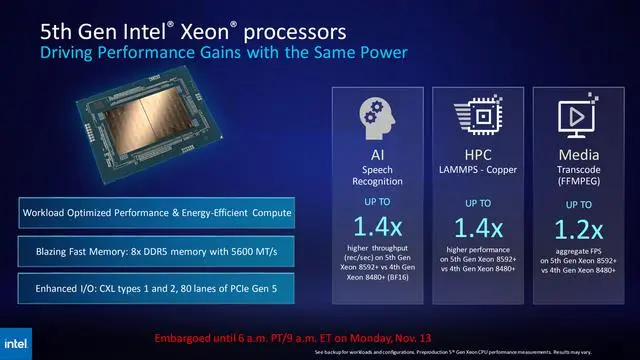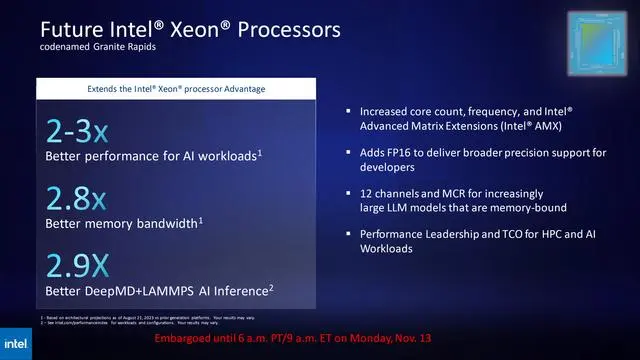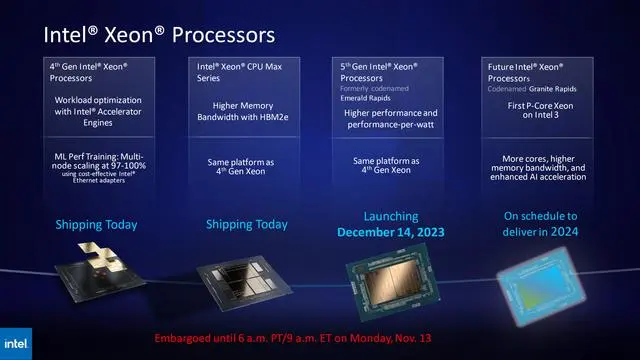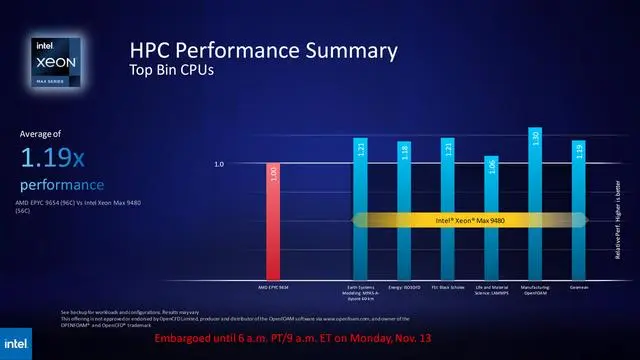Intel's Fifth Generation Emerald Rapids and Next Generation Granite Rapids Xeon CPU Performance Revealed
Intel claims that the performance of the fifth generation Emerald Rapids has improved by 40% compared to the fourth generation.
Intel's fifth generation Emerald Rapids are compatible with the Sapphire Rapids pins on the Eagle Stream platform, using the same LGA-4677 slot. The main upgrade is to optimize the design and provide a larger cache pool and better energy efficiency.
The company emphasizes that Emerald Rapids will provide performance and energy-efficient computing optimized for workloads, while also introducing faster DDR5-5600 memory, resulting in higher bandwidth and transmission speed.
The fifth generation Xeon will also provide CXL 1.0 and 2.0 support, as well as up to 80 PCIe Gen 5.0 channels. IT Home Summary Details:
Intel Emerald Rapids (64 core Xeon 8592+) and Sapphire Rapids (56 core Xeon 8480+):
AI speech recognition: 1.4x
HPC LAMMPS (Copper): 1.4x
Media Transcoding (FFMPEG): 1.2x
In addition, the fifth generation Xeon "Emerald Rapids" CPU also includes improvements in the following areas:
Triple size LLC cache
Faster memory speed
Higher CPU cores (up to 64 cores)
CXL Type 3 High Bandwidth Interface
Workload Optimization (Intel AE)
Optimized power mode
17% improvement in universal performance per watt
Uninstalling CPU cores through Intel accelerator engine to improve energy efficiency
Significant performance improvement in reasoning and training
Intel AMX with built-in AI acceleration
Pre installed optimized software stack
Intel has also released internal performance prediction benchmarks for Granite Rapids Xeon CPUs, all of which are designed with full large cores, while Sierra Forest will adopt E-cores, providing up to 288 cores.
These chips will be compatible with the next generation Birch Stream platform, which has two different slots, LGA 4710 and LGA 7529.
Intel also confirmed that the Granite Rapids Xeon CPU will provide more cores, higher frequencies, and Intel AMX (Advanced Matrix Extension) support.
In addition, Granite Rapids will also add FP16 to expand precision support for AI based developers. The platform will provide 12 channel MCRDIMM support to address memory constrained large LLM models.
In terms of performance, compared to the existing fourth generation Sapphire Rapids CPU, Intel estimates that the Granite Rapids chip will achieve a 2.9x improvement in AI inference (DeepMD+LAAMPS), a 2.8x improvement in memory bandwidth, and nearly 3x performance improvement in AI workload. Of course, these are only rough performance predictions, and the final performance test results may vary.
Finally, Intel also presented some HPC performance benchmarks for its Xeon Max 9480 CPU, which has 56 cores and 64GB of HBM memory. Compared with the AMD EPYC 9654 with 96 cores, the Xeon Max CPU has a 30% performance advantage, while the EPYC 9645 is $11805 (IT Home note: currently approximately 86058 RMB) and the Xeon Max 9480 is $12980 (currently approximately 94624 RMB).
Both CPUs have a rated power of 360/350W, but Sapphire Rapids have higher CPU power, which may result in lower overall cost (TCO) compared to AMD solutions. In addition, AMD also offers its 3D V-Cache enhancement products in the Genoa X series, which can provide more competitive performance in these bandwidth limited workload scenarios.
In summary, Intel will launch its fifth generation Xeon Emerald Rapids CPU series on December 14th, while Granite Rapids CPUs will make their debut in the second half of 2024 shortly after Sierra Forest. Stay tuned.
(Extract from IT Home)


